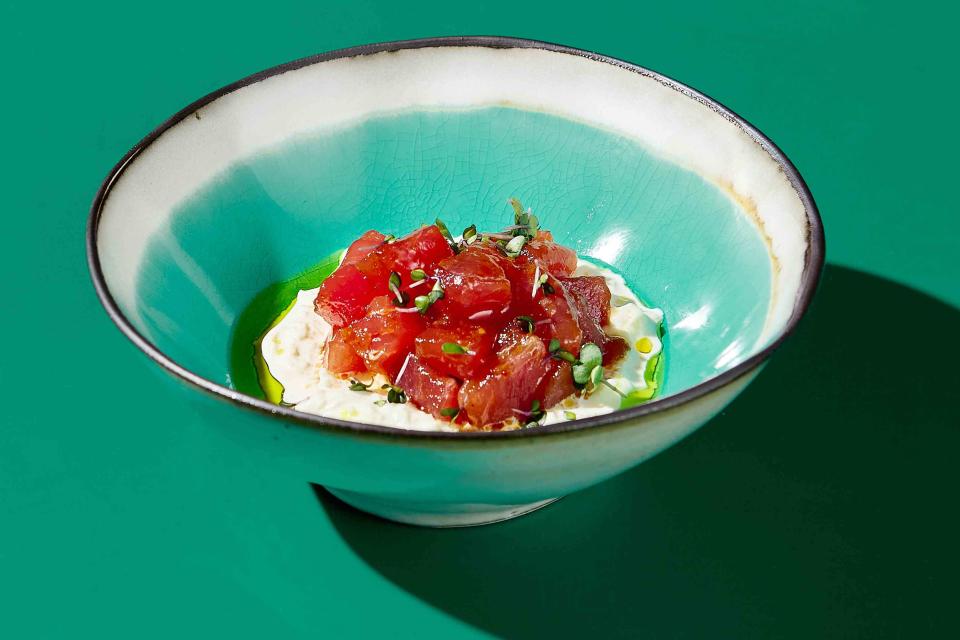How to Make Easy Tuna Tartare in 10 Minutes
Whip up the restaurant-quality dish at home.

Ryzhkov/Getty Images
Tartare may be a polarizing dish to many Americans, but raw protein is common across the globe, easy to prepare, and delicious to eat. Tuna tartare is a seafood-specific riff on the common beef tartare, which uses chopped raw steak. The specific origins of the dish, however, are unclear, but tuna tartare was popularized in the 1980s, thanks to a Beverly Hills restaurant cranking out the chic pink dish.
Now, tuna tartare is commonplace in restaurants across the country, offering seemingly endless riffs, culinary influences, and international interpretations of the dish. And making tuna tartare at home, to enjoy on crackers, by the spoonful, or however you wish, can be quite simple and luxurious. Think of it as an elevated tuna salad.
When buying tuna to make tuna tartare yourself, there are a few factors to keep in mind. “The species used is actually less important than the quality of the fish,” says Robert Digregorio AKA ‘Bobby Tuna’, Director of Seafood Quality at FultonFishMarket.com. “You can use yellowfin, bigeye, or bluefin [tuna], but the important thing is the quality of the fish.”
Related: How to Buy the Best Fish at the Grocery Store, According to Fishmongers
Quality wise, you’re looking for #1 sushi-grade tuna for tuna tartare. “That means it must be super fresh, preferably with a good amount of fat,” says Digregorio. “Fresh is great, but fresh super frozen is actually preferable because the quality is locked in. While the freshness of tuna is always a delicate matter and will change day to day, the quality of super frozen tuna will remain.”
Most restaurants are working with flash-frozen tuna to ensure quality and taste, and that’s absolutely fine to use at home too. To defrost tuna, put the packaged tuna in a bowl of cold water and let it rest for 15 minutes. Once the water is too chilled, switch it out with fresh water, until the tuna is thawed through, which depends on the size of the filet.
Tuna tartare is all about the cut, and the size and chop is completely up to the cook’s preference. Some people enjoy a smooth tuna tartare, while others prefer small cubes of fish, like in Hawaiian poke.
“Some people use a knife or a food processor and chop the tuna very, very finely into almost a paste,” says Digregorio. “I prefer more texture, so I’ll cut the piece lengthwise first, then cut it into thin strips, one-fourth of an inch or so, and then dice it into ¼-inch cubes. This method ensures a pretty even size.”
Cutting across the grain makes the pieces even more tender, and your fish doesn’t have to be completely thawed to slice it. In fact, a slightly frozen fish is firmer and simpler to cut.
Ready to tartare? Here’s how to make tuna tartare.
Related: 16 Healthy Fish and Shrimp Recipes for Any Night of the Week
Tuna Tartare Recipe
Ingredients:
1 pound sushi-grade tuna, thawed and cut to your liking
1 tsp grated garlic
1 tsp grated ginger
1 tbsp soy sauce (or tamari, for a gluten-free dish)
1 tbsp sesame oil
2 tsps fresh lime juice
1 tsp wasabi paste or sriracha (optional, for heat)
Fresh herbs and sesame seeds, for garnish
Mix aromatics and sauces in a medium bowl to combine. This can be done up to one day ahead of adding the tuna. Taste and season as desired.
Gently stir in cut tuna, coating it in the marinade. Add the sesame seeds and herbs just before serving.
Serve tuna tartare in small bowls, on puffed rice paper, on a bed of chopped or thinly sliced avocado, or however you prefer. Jalapeños or chilis can also be diced and added to the tartare for more heat and texture.
Is Tuna Tartare Healthy?
Tuna is a great source of omega-3 fatty acids, which can help reduce cholesterol and prevent heart disease. Tuna is also high in vitamin B12, high in protein, and relatively low in calories. Tuna tartare is also naturally low in carbohydrates, low in sugar, and is gluten-free. Tuna tartare can be served with whole grains, legumes, and veggies for added nutrients, such as fiber and vitamins.
Is Tuna Tartare Safe to Eat?
Raw tuna is safe to eat. “Tuna is one of the only fishes that the FDA does not insist on being frozen before being deemed safe for raw consumption,” says Digregorio. ”The FDA has exempted tuna from mandatory freezing because the related, documented incident rate of people becoming sick from tuna is so low, it’s a non-issue.”
Related: How to Cook Fish
As with anything, it’s important to keep food safety precautions in mind when preparing and enjoying tuna tartare. Raw tuna should be kept at a safe temperature at all times, stored at 40 degrees Fahrenheit or lower in the refrigerator. Once the tuna is prepared, it will warm to room temperature, and won’t be safe to eat after two hours outside of the fridge.
“Another quality check to tell if your tuna is fresh or not is the smell,” says Digregorio. “Fresh tuna should have a clean, fresh smell. If it smells strong and fishy, or sour and unpleasant, your nose is telling you to not eat it. It is very important to know and trust your fish source.”
For more Real Simple news, make sure to sign up for our newsletter!
Read the original article on Real Simple.

